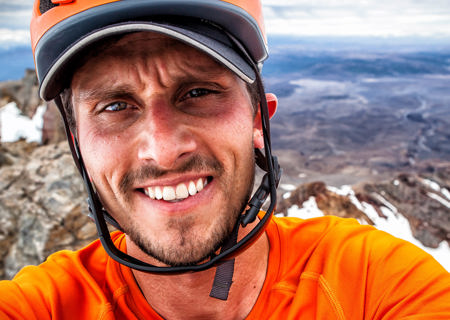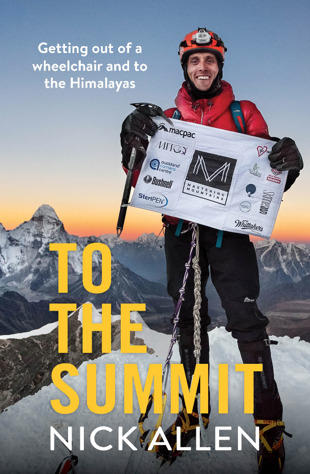Now that it’s published, what delights you most about To the Summit?
Most definitely the photos — they look great! In part, this thrill comes from the fact that I don’t often see my photos printed. However, the thing that I love most is the combination of matt paper, its weight and smell, and the edge-to-edge printing. All this gives the book a really satisfying feel, one that I certainly enjoy.
Is it one of the toughest things you’ve ever done?
Writing To the Summit was by far the hardest thing I have ever done. Climbing a 6000m peak in the Himalayas and the months of preparation were easier than writing the book! While I knew the act of writing was going to be a challenge, the thing I did not anticipate was the emotional response to revisiting some of the most difficult times of my life. I realise now that there was a lot of stuff I had not processed and this was incredibly confronting to me. Hopefully the result of this is a more insightful and interesting read.
Tell us about one new thing that you discovered while writing it
One of the biggest things I learnt was the value of an editorial team. I was both surprised and thrilled to see how much the book improved and took shape through the contributions of different people throughout the editing process. For this reason, I am deeply grateful for the awesome team at MUP and their help in taking the book up a couple of notches.
What’s the best time of day for you for writing? And where do you like to write?
Late morning is the best time for me. It takes me a while to get into the groove, so to speak. Typically, I would start early and spend an hour or so rereading what I had written over the previous few days, to help clarify and regain my train of thought. When it came to writing again, the first little while would be a slog as I attempted to set the trajectory for the day. Gradually, this would get easier and then by 11.00 or so, I would (generally) be into it, writing at a good rate of knots.
How did you keep yourself going on those writing days when energy levels flagged?
I was very grateful for the support of MitoQ, a pharmaceutical company that supplied me with a supplement designed to increase energy in people with neurological problems. This was a huge help to me and gave me the mental clarity to keep going, even when I my body was tired. Towards the end of the writing process, I was exhausted in every regard and really struggled. This is when friends and family were key, encouraging me to keep it up. On many of those days when energy flagged, it was a case of just sitting and typing, no matter what.
You love the outdoors, and wild places. Can you explain why?
I do love being outdoors in wild places! I love being completely cut off from everyone — no emails, Facebook, texts or phone calls. For me, this is bliss. I also love being out in wild places because it reminds me of how massive and amazing the world is — how much there is to take pleasure in and be happy about. I try my best to be totally present when I tramp and climb, to simply enjoy. This process of enjoying the marvellous beauty of the landscape and all it contains reminds me that my problems and struggles are actually very small, and that I have much to be grateful for. The combination of these two aspects — alone time and enjoyment of the landscape — recharges me and makes me feel stronger.
What do you hope readers will learn from your book?
There are a couple of things I hope readers will take away from the book. First, I hope that it encourages people with disabilities or difficulties not to give up hope. I wish someone had told me that a disability does not mean the end of a fulfilling life. Second, I hope that all people — even those who are fit and healthy — are encouraged to get outdoors more and pursue a healthy lifestyle.
What’s the next big outdoors adventure for you?
Good question! The next BIG adventure is an attempt on Ama Dablam (6812m) in Nepal, planned for May 2018. In the meantime, I hope to get down to the South Island and do a good deal of climbing.
You are enrolled at Massey to do a PhD. What’s that going to focus on?
My PhD is going to look at the New Zealand Alpine Journal and the concept of the New Zealand climber. What I am hoping to track is the changing ways in which climbers have viewed themselves in relationship to the landscape. For example, I would like to chart the change from early climbing as part of the Imperial conquest of the land, to modern climbing as a means of conquering some internal landscape. I am really excited about this project and look forward to seeing how it develops.
What are you reading at the moment?
Jane Eyre, by Charlotte Brontë — my all-time favourite book, with its truly beautiful story.


